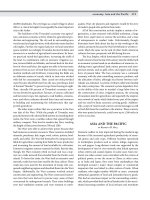Encyclopedia of society and culture in the medieval world (4 volume set) ( facts on file library of world history ) ( PDFDrive ) 765
Bạn đang xem bản rút gọn của tài liệu. Xem và tải ngay bản đầy đủ của tài liệu tại đây (88.92 KB, 1 trang )
738 money and coinage: Europe
Merovingian kingdom and likewise changed from gold to silver in the course of the seventh century.
The most significant changes to the Byzantine coinage
in the eighth through 12th centuries were in the gold issues,
which changed in content and appearance. Originally of 24carat metal, Byzantine gold coins underwent a series of debasements until by the 11th century they contained no more
than 8 carats, or one-third gold and two-thirds silver. In the
same period they became broader and went from being flat
to concave. Silver coinage continued to be erratic in standard
and was in most periods rare. Copper coinage was plentiful,
especially the follis denomination. Beginning in the late ninth
century folles ceased to bear the name of the emperor, and
the large series of anonymous folles of the 10th and 11th centuries had mainly Christian religious images and legends.
In Europe the coinage of the central Middle Ages was
almost entirely in silver and of a single denomination, the
penny. This coinage grew out of the debased tremisses of the
seventh century in France and England. In the late eighth
century Charlemagne on the continent and Offa in England
reformed the coinage to create pennies of consistent standard
and appearance. The penny denomination spread to Italy and
beyond the limits of the ancient Roman Empire as coinage
expanded across the continent. By the 12th century silver
pennies were issued by hundreds of minters throughout Europe, and each minter used its own images and standards of
weight and fineness. Although pennies were the only coins
regularly minted, they were recorded by the terms shilling for
12 pennies and pound for 240 pennies.
In England the issue of pennies remained in royal control and continued the ancient Roman practice of featuring
the image of the ruler on the obverse (the front of the coin).
Pottery money box; London, 1300s (© Museum of London)
Silver penny of King Alfred; Britain, ca. 886–99 (© Museum of London)
In France royal issues were only a small part of the coinage
after the breakup of the Carolingian Empire in the ninth
century; coins of seigneurial rulers and of bishops and abbots predominated. In Germany the coinages of lords below
the imperial and royal levels were also of great importance; a
special class of German pennies was the 12th-century bracteates, which were very broad and thin silver pennies whose
artistic images were stamped on one side only. In Italy the
coinages of communes (self-governing towns) were the main
issues of the central Middle Ages; the most apparent development among their pennies was the frequent debasements
that brought some of them to be mostly copper by the 12th
century. Pennies of the new states of Scandinavia and eastern
Europe were usually royal in origin, while those of the crusader states of the Levant and Greece generally followed the
seigneurial model familiar to the French settlers who made
up much of their ruling class.
The debasement of the Byzantine precious metal coinage was brought to an end by the reforms of Alexius I Comnenus (r. 1081–1118) at the end of the 11th century. Instead
of a system of coins of pure gold, silver, and bronze, the late
Byzantine coinage was based on a series of denominations
of alloys of the three metals, with the highest-value coin being the hyperpyron of about 85 percent gold and 15 percent
silver. The coins of all denominations remained concave. No
coinage was minted in the names of the Latin rulers who conquered Constantinople in 1204, though some imitations of









